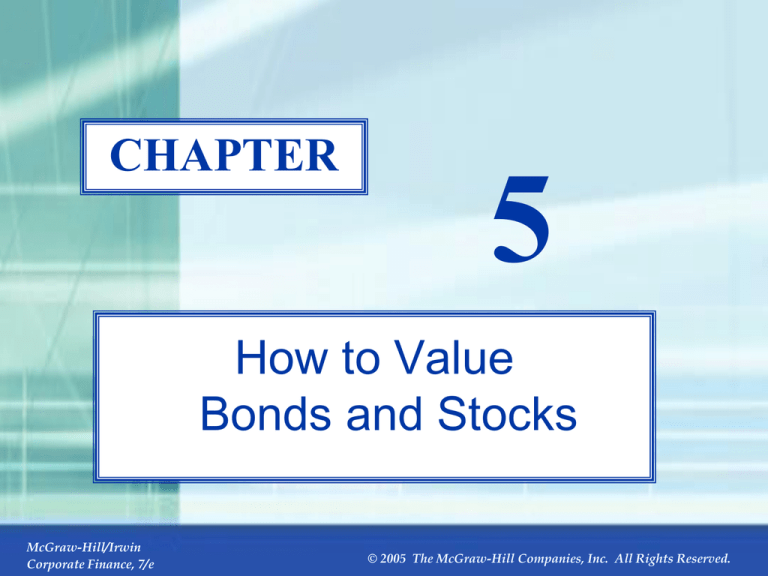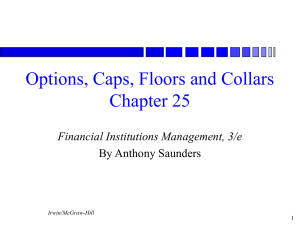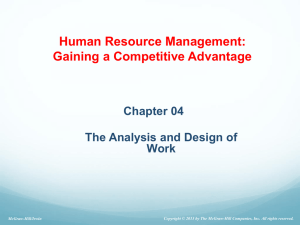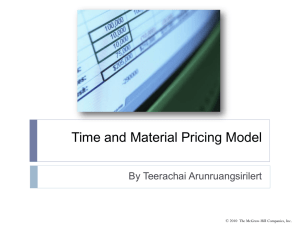
5-0
CHAPTER
5
How to Value
Bonds and Stocks
McGraw-Hill/Irwin
Corporate Finance, 7/e
© 2005 The McGraw-Hill Companies, Inc. All Rights Reserved.
5-1
Chapter Outline
5.1
5.2
5.3
5.4
5.5
5.6
5.7
5.8
5.9
5.10
Definition and Example of a Bond
How to Value Bonds
Bond Concepts
The Present Value of Common Stocks
Estimates of Parameters in the Dividend-Discount Model
Growth Opportunities
The Dividend Growth Model and the NPVGO Model
(Advanced)
Price Earnings Ratio
Stock Market Reporting
Summary and Conclusions
McGraw-Hill/Irwin
Corporate Finance, 7/e
© 2005 The McGraw-Hill Companies, Inc. All Rights Reserved.
5-2
Valuation of Bonds and Stock
First Principles:
Value of financial securities = PV of expected future
cash flows
To value bonds and stocks we need to:
Estimate future cash flows:
Size (how much) and
Timing (when)
Discount future cash flows at an appropriate rate:
The rate should be appropriate to the risk presented by the
security.
McGraw-Hill/Irwin
Corporate Finance, 7/e
© 2005 The McGraw-Hill Companies, Inc. All Rights Reserved.
5-3
5.1 Definition and Example
of a Bond
A bond is a legally binding agreement between a
borrower and a lender:
Specifies the principal amount of the loan.
Specifies the size and timing of the cash flows:
In dollar terms (fixed-rate borrowing)
As a formula (adjustable-rate borrowing)
McGraw-Hill/Irwin
Corporate Finance, 7/e
© 2005 The McGraw-Hill Companies, Inc. All Rights Reserved.
5-4
5.1 Definition and Example
of a Bond
Consider a U.S. government bond listed as 6 3/8 of December
2009.
The Par Value of the bond is $1,000.
Coupon payments are made semi-annually (June 30 and December 31 for
this particular bond).
Since the coupon rate is 6 3/8 the payment is $31.875.
On January 1, 2005 the size and timing of cash flows are:
$31.875 $31.875
$31.875
$1,031.875
6 / 30 / 09
12 / 31 / 09
1 / 1 / 05
6 / 30 / 05
McGraw-Hill/Irwin
Corporate Finance, 7/e
12 / 31 / 05
© 2005 The McGraw-Hill Companies, Inc. All Rights Reserved.
5-5
5.2 How to Value Bonds
Identify the size and timing of cash flows.
Discount at the correct discount rate.
If you know the price of a bond and the size and
timing of cash flows, the yield to maturity is the
discount rate.
McGraw-Hill/Irwin
Corporate Finance, 7/e
© 2005 The McGraw-Hill Companies, Inc. All Rights Reserved.
5-6
Pure Discount Bonds
Information needed for valuing pure discount bonds:
Time to maturity (T) = Maturity date - today’s date
Face value (F)
Discount rate (r)
$0
$0
$0
$F
T 1
T
0
1
2
Present value of a pure discount bond at time 0:
F
PV
T
(1 r )
McGraw-Hill/Irwin
Corporate Finance, 7/e
© 2005 The McGraw-Hill Companies, Inc. All Rights Reserved.
5-7
Pure Discount Bonds: Example
Find the value of a 30-year zero-coupon bond with
a $1,000 par value and a YTM of 6%.
$0
$0
$0
$1,000
$0
29
0
1
2
29
30
F
$1,000
PV
$174.11
T
30
(1 r )
(1.06)
McGraw-Hill/Irwin
Corporate Finance, 7/e
© 2005 The McGraw-Hill Companies, Inc. All Rights Reserved.
5-8
Pure Discount Bonds: Example
Find the value of a 30-year zero-coupon bond with
a $1,000 par value and a YTM of 6%.
N
30
I/Y
6
PV
174.11
PMT
FV
McGraw-Hill/Irwin
Corporate Finance, 7/e
1,000
© 2005 The McGraw-Hill Companies, Inc. All Rights Reserved.
5-9
Level-Coupon Bonds
Information needed to value level-coupon bonds:
Coupon payment dates and time to maturity (T)
Coupon payment (C) per period and Face value (F)
Discount rate
$C
$C
$C
$C $F
T 1
T
0
1
2
Value of a Level-coupon bond
= PV of coupon payment annuity + PV of face value
C
1
F
PV 1
T
r (1 r ) (1 r )T
McGraw-Hill/Irwin
Corporate Finance, 7/e
© 2005 The McGraw-Hill Companies, Inc. All Rights Reserved.
5-10
Level-Coupon Bonds: Example
Find the present value (as of January 1, 2004), of a 6-3/8 coupon Tbond with semi-annual payments, and a maturity date of
December 2009 if the YTM is 5-percent.
On January 1, 2004 the size and timing of cash flows are:
$31.875 $31.875
$31.875
$1,031.875
6 / 30 / 09
12 / 31 / 09
1 / 1 / 04 6 / 30 / 04
12 / 31 / 04
$1,000
$31.875
1
PV
1
$1,070.52
12
12
.05 2 (1.025) (1.025)
McGraw-Hill/Irwin
Corporate Finance, 7/e
© 2005 The McGraw-Hill Companies, Inc. All Rights Reserved.
5-11
Level-Coupon Bonds: Example
Find the present value (as of January 1, 2004), of a
6-3/8 coupon T-bond with semi-annual payments, and
a maturity date of December 2009 if the YTM is
5-percent.
N
I/Y
PV
PMT
12
5
– 1,070.52
31.875 =
1,000×0.06375
2
FV
McGraw-Hill/Irwin
Corporate Finance, 7/e
1,000
© 2005 The McGraw-Hill Companies, Inc. All Rights Reserved.
5-12
5.3 Bond Concepts
1.
Bond prices and market interest rates move in opposite
directions.
2.
When coupon rate = YTM, price = par value.
When coupon rate > YTM, price > par value (premium bond)
When coupon rate < YTM, price < par value (discount bond)
3.
A bond with longer maturity has higher relative (%) price
change than one with shorter maturity when interest rate (YTM)
changes. All other features are identical.
4.
A lower coupon bond has a higher relative price change than a
higher coupon bond when YTM changes. All other features are
identical.
McGraw-Hill/Irwin
Corporate Finance, 7/e
© 2005 The McGraw-Hill Companies, Inc. All Rights Reserved.
5-13
YTM and Bond Value
When the YTM < coupon, the bond
trades at a premium.
Bond Value
$1400
1300
1200
When the YTM = coupon, the
bond trades at par.
1100
1000
800
0
0.01
0.02
0.03
0.04
0.05
0.06 0.07
6 3/8
0.08
0.09
0.1
Discount Rate
When the YTM > coupon, the bond trades at a discount.
McGraw-Hill/Irwin
Corporate Finance, 7/e
© 2005 The McGraw-Hill Companies, Inc. All Rights Reserved.
5-14
Bond Value
Maturity and Bond Price Volatility
Consider two otherwise identical
bonds.
The long-maturity bond will have
much more volatility with respect to
changes in the discount rate
Par
Short Maturity Bond
C
Discount Rate
Long Maturity Bond
McGraw-Hill/Irwin
Corporate Finance, 7/e
© 2005 The McGraw-Hill Companies, Inc. All Rights Reserved.
5-15
Bond Value
Coupon Rate and Bond Price
Volatility
Consider two otherwise identical bonds.
The low-coupon bond will have much more
volatility with respect to changes in the
discount rate
High Coupon Bond
Discount Rate
Low Coupon Bond
McGraw-Hill/Irwin
Corporate Finance, 7/e
© 2005 The McGraw-Hill Companies, Inc. All Rights Reserved.
5-16
5.4 The Present Value
of Common Stocks
Dividends versus Capital Gains
Valuation of Different Types of Stocks
Zero Growth
Constant Growth
Differential Growth
McGraw-Hill/Irwin
Corporate Finance, 7/e
© 2005 The McGraw-Hill Companies, Inc. All Rights Reserved.
5-17
Case 1: Zero Growth
Assume that dividends will remain at the same level
forever
Div1 Div2 Div3
Since future cash flows are constant, the value of a
zero growth stock is the present value of a
perpetuity:
Div1
Div 2
Div 3
1
2
3
(1 r )
(1 r )
(1 r )
Div
P0
r
P0
McGraw-Hill/Irwin
Corporate Finance, 7/e
© 2005 The McGraw-Hill Companies, Inc. All Rights Reserved.
5-18
Case 2: Constant Growth
Assume that dividends will grow at a constant
rate, g, forever. i.e.
Div1 Div0 (1 g )
2
Div2 Div1 (1 g ) Div0 (1 g )
3
Div3 Div
(
1
g
)
Div
(
1
g
)
0
.2
..
Since future cash flows grow at a constant rate
forever, the value of a constant growth stock
is the present value of a growing perpetuity:
Div1
P0
r g
McGraw-Hill/Irwin
Corporate Finance, 7/e
© 2005 The McGraw-Hill Companies, Inc. All Rights Reserved.
5-19
Case 3: Differential Growth
Assume that dividends will grow at different rates
in the foreseeable future and then will grow at a
constant rate thereafter.
To value a Differential Growth Stock, we need to:
Estimate future dividends in the foreseeable future.
Estimate the future stock price when the stock
becomes a Constant Growth Stock (case 2).
Compute the total present value of the estimated
future dividends and future stock price at the
appropriate discount rate.
McGraw-Hill/Irwin
Corporate Finance, 7/e
© 2005 The McGraw-Hill Companies, Inc. All Rights Reserved.
5-20
Case 3: Differential Growth
Assume that dividends will grow at rate g1
for N years and grow at rate g2 thereafter
Div1 Div0 (1 g1 )
2
Div2 Div1 (1 g1 ) Div0 (1 g1 )
..
.
N
DivN DivN 1 (1 g1 ) Div0 (1 g1 )
DivN 1 DivN (1 g2 ) Div0 (1 g1 )N (1 g2 )
..
.
McGraw-Hill/Irwin
Corporate Finance, 7/e
© 2005 The McGraw-Hill Companies, Inc. All Rights Reserved.
5-21
Case 3: Differential Growth
Dividends will grow at rate g1 for N years
and grow at rate g2 thereafter
2
Div0 (1 g1 ) Div0 (1 g1 )
…
0
1
2
Div0 (1 g1 )N
DivN (1 g2 )
Div0 (1 g1 )N (1 g2 )
…
…
N
McGraw-Hill/Irwin
Corporate Finance, 7/e
N+1
© 2005 The McGraw-Hill Companies, Inc. All Rights Reserved.
5-22
Case 3: Differential Growth
We can value this as the sum of:
an N-year annuity growing at rate g1
T
C
(1 g1 )
PA
1
T
r g1 (1 r )
plus the discounted value of a perpetuity
growing at rate g2 that starts in year N+1
DivN 1
r g2
PB
(1 r )N
McGraw-Hill/Irwin
Corporate Finance, 7/e
© 2005 The McGraw-Hill Companies, Inc. All Rights Reserved.
5-23
Case 3: Differential Growth
To value a Differential Growth Stock, we can use
DivN 1
T
C
(1 g1 ) r g2
P
1
T
N
r g1 (1 r ) (1 r )
Or we can cash flow it out.
McGraw-Hill/Irwin
Corporate Finance, 7/e
© 2005 The McGraw-Hill Companies, Inc. All Rights Reserved.
5-24
A Differential Growth Example
A common stock just paid a dividend of $2. The dividend is
expected to grow at 8% for 3 years, then it will grow at
4% in perpetuity.
What is the stock worth? The discount rate is 12%.
McGraw-Hill/Irwin
Corporate Finance, 7/e
© 2005 The McGraw-Hill Companies, Inc. All Rights Reserved.
5-25
With the Formula
DivN 1
T
C
(1 g1 ) r g2
P
1
r g1 (1 r )T (1 r )N
$2(1.08)3 (1.04)
3
(1.08)
.12 .04
$
2
(
1
.
08
)
1
P
3
3
.12 .08 (1.12)
(1.12)
(
$32.75 )
P $54 [1 . 8966]
(1.12)3
P $5.58 $23.31
P $28.89
McGraw-Hill/Irwin
Corporate Finance, 7/e
© 2005 The McGraw-Hill Companies, Inc. All Rights Reserved.
5-26
A Differential Growth Example (continued)
$2(1.08)
0
1
$2.16
0
2
$2(1.08)
2
$2.33
$2(1.08)3 $2(1.08)3 (1.04)
…
3
$2.62
$2.52
.08
4 The constant
growth phase
beginning in year 4
can be valued as a
growing perpetuity
at time 3.
$2.62
P3
$32.75
.08
$2.16 $2.33 $2.52 $32.75
$28.89
P0
2
3
1.12 (1.12)
(1.12)
1
McGraw-Hill/Irwin
Corporate Finance, 7/e
2
3
© 2005 The McGraw-Hill Companies, Inc. All Rights Reserved.
5-27
A Differential Growth Example (continued)
A common stock just paid a dividend of $2. The dividend is
expected to grow at 8% for 3 years, then it will grow at 4%
in perpetuity. What is the stock worth?
$28.89 = 5.58 + 23.31
First find the PV of the supernormal dividend stream then find
the PV of the steady-state dividend stream.
N
N
3
1.12
I/Y
3.70 =
PV
– 5.58
PMT
FV
McGraw-Hill/Irwin
Corporate Finance, 7/e
$2 =
0
1.08
3
–1 ×100 I/Y
2×1.08
12
PV
– 23.31
PMT
0
1.08
FV
2×(1.08)3 ×(1.04)
32.75 =
.08
© 2005 The McGraw-Hill Companies, Inc. All Rights Reserved.
5-28
5.5 Estimates of Parameters in the
Dividend-Discount Model
The value of a firm depends upon its growth rate,
g, and its discount rate, r.
Where does g come from?
Where does r come from?
McGraw-Hill/Irwin
Corporate Finance, 7/e
© 2005 The McGraw-Hill Companies, Inc. All Rights Reserved.
5-29
Where does g come from?
g = Retention ratio × Return on retained earnings
McGraw-Hill/Irwin
Corporate Finance, 7/e
© 2005 The McGraw-Hill Companies, Inc. All Rights Reserved.
5-30
Where does r come from?
The discount rate can be broken into two parts.
The dividend yield
The growth rate (in dividends)
In practice, there is a great deal of estimation
error involved in estimating r.
McGraw-Hill/Irwin
Corporate Finance, 7/e
© 2005 The McGraw-Hill Companies, Inc. All Rights Reserved.
5-31
5.6 Growth Opportunities
Growth opportunities are opportunities to invest
in positive NPV projects.
The value of a firm can be conceptualized as the
sum of the value of a firm that pays out 100percent of its earnings as dividends and the net
present value of the growth opportunities.
EPS
NPVGO
P
r
McGraw-Hill/Irwin
Corporate Finance, 7/e
© 2005 The McGraw-Hill Companies, Inc. All Rights Reserved.
5-32
5.7 The Dividend Growth Model and
the NPVGO Model (Advanced)
We have two ways to value a stock:
The dividend discount model.
The price of a share of stock can be calculated as the
sum of its price as a cash cow plus the per-share value
of its growth opportunities.
McGraw-Hill/Irwin
Corporate Finance, 7/e
© 2005 The McGraw-Hill Companies, Inc. All Rights Reserved.
5-33
The Dividend Growth Model and the
NPVGO Model
Consider a firm that has EPS of $5 at the end of the first
year, a dividend-payout ratio of 30%, a discount rate of
16-percent, and a return on retained earnings of 20percent.
The dividend at year one will be $5 × .30 = $1.50 per share.
The retention ratio is .70 ( = 1 -.30) implying a growth rate in
dividends of 14% = .70 × 20%
From the dividend growth model, the price of a share is:
Div1
$1.50
$75
P0
r g .16 .14
McGraw-Hill/Irwin
Corporate Finance, 7/e
© 2005 The McGraw-Hill Companies, Inc. All Rights Reserved.
5-34
The NPVGO Model
First, we must calculate the value of the
firm as a cash cow.
Div1 $5
$31.25
P0
r
.16
Second, we must calculate the value of the
growth opportunities.
.20
3
.
50
3.50 .16
$.875
$43.75
P0
r g
.16 .14
Finally,
McGraw-Hill/Irwin
Corporate Finance, 7/e
P0 31.25 43.75 $75
© 2005 The McGraw-Hill Companies, Inc. All Rights Reserved.
5-35
5.8 Price Earnings Ratio
Many analysts frequently relate earnings per share to
price.
The price earnings ratio is a.k.a. the multiple
Calculated as current stock price divided by annual EPS
The Wall Street Journal uses last 4 quarter’s earnings
Price per share
P/E ratio
EPS
Firms whose shares are “in fashion” sell at high multiples. Growth
stocks for example.
Firms whose shares are out of favor sell at low multiples. Value
stocks for example.
McGraw-Hill/Irwin
Corporate Finance, 7/e
© 2005 The McGraw-Hill Companies, Inc. All Rights Reserved.
5-36
Other Price Ratio Analysis
Many analysts frequently relate earnings per
share to variables other than price, e.g.:
Price/Cash Flow Ratio
cash flow = net income + depreciation = cash flow
from operations or operating cash flow
Price/Sales
current stock price divided by annual sales per share
Price/Book (a.k.a. Market to Book Ratio)
price divided by book value of equity, which is
measured as assets – liabilities
McGraw-Hill/Irwin
Corporate Finance, 7/e
© 2005 The McGraw-Hill Companies, Inc. All Rights Reserved.
5-37
5.9 Stock Market Reporting
52 WEEKS
YLD
VOL
NET
HI
LO STOCK SYM DIV % PE 100s HI LO CLOSE CHG
52.75 19.06 Gap Inc GPS 0.09 0.5 15 65172 20.50 19 19.25 -1.75
Gap has
been as
high as
$52.75 in
the last
year.
Gap pays a
dividend of 9
cents/share
Given the
current price,
the dividend
yield is ½ %
Gap has
been as low
as $19.06 in
the last year.
McGraw-Hill/Irwin
Corporate Finance, 7/e
Gap ended trading
at $19.25, down
$1.75 from
yesterday’s close
Given the
current price, the
PE ratio is 15
times earnings
6,517,200 shares
traded hands in the
last day’s trading
© 2005 The McGraw-Hill Companies, Inc. All Rights Reserved.
5-38
5.9 Stock Market Reporting
52 WEEKS
YLD
VOL
NET
HI
LO STOCK SYM DIV % PE 100s HI LO CLOSE CHG
52.75 19.06 Gap Inc GPS 0.09 0.5 15 65172 20.50 19 19.25 -1.75
Gap Incorporated is having a tough year, trading near their
52-week low. Imagine how you would feel if within the
past year you had paid $52.75 for a share of Gap and now
had a share worth $19.25! That 9-cent dividend wouldn’t
go very far in making amends.
Yesterday, Gap had another rough day in a rough year. Gap
“opened the day down” beginning trading at $20.50,
which was down from the previous close of $21.00 =
$19.25 + $1.75
Looks like cargo pants aren’t the only things on sale at Gap.
McGraw-Hill/Irwin
Corporate Finance, 7/e
© 2005 The McGraw-Hill Companies, Inc. All Rights Reserved.
5-39
5.10
Summary and Conclusions
In this chapter, we used the time value of money
formulae from previous chapters to value bonds
and stocks.
1. The value of a zero-coupon bond is
F
PV
T
(1 r )
C
2. The value of a perpetuity is
PV
r
McGraw-Hill/Irwin
Corporate Finance, 7/e
© 2005 The McGraw-Hill Companies, Inc. All Rights Reserved.
5-40
5.10 Summary and Conclusions (continued)
3. The value of a coupon bond is the sum of the
PV of the annuity of coupon payments plus the
PV of the par value at maturity.
C
PV
r
1
F
1 T T
(1 r ) (1 r )
The yield to maturity (YTM) of a bond is that single rate that
discounts the payments on the bond to the purchase price.
McGraw-Hill/Irwin
Corporate Finance, 7/e
© 2005 The McGraw-Hill Companies, Inc. All Rights Reserved.
5-41
5.10 Summary and Conclusions (continued)
5. A stock can be valued by discounting its
dividends. There are three cases:
Div
Zero growth in dividends P0
r
Div1
Constant growth in
P0
r g
dividends
DivN 1
Differential growth in dividends
r g
T
C
(
1
g
2
1)
P
1
T
N
r g1 (1 r ) (1 r )
McGraw-Hill/Irwin
Corporate Finance, 7/e
© 2005 The McGraw-Hill Companies, Inc. All Rights Reserved.
5-42
5.10 Summary and Conclusions (continued)
6. The growth rate can be estimated as:
g = Retention ratio × Return on retained earnings
7. An alternative method of valuing a stock was
presented, the NPVGO values a stock as the
sum of its “cash cow” value plus the present
value of growth opportunities.
EPS
NPVGO
P
r
McGraw-Hill/Irwin
Corporate Finance, 7/e
© 2005 The McGraw-Hill Companies, Inc. All Rights Reserved.









